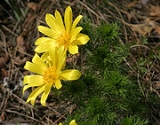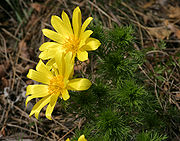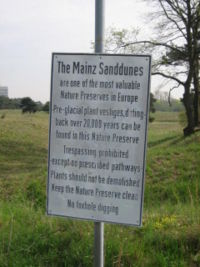
Mainz Sand Dunes
Encyclopedia
The Mainz Sand Dunes are a small geological and botanical supra-region and important nature preserve in Mainz
, Germany. Within this protected area rare plants and animals can be found. Some of the species represented here, such as as the Purple Golden-drop, (Onosma
arenaria) grow only here and in small numbers.
 The sand dunes developed after the last ice age
The sand dunes developed after the last ice age
(Würm glaciation) and the first resettlement of grassland
plants occurred approximately 12,000 years ago. The dry sandy soils are poor of nutrients but relict flora from the glaciation grasslands grow favorably. These plants are found otherwise only in southeast-European, inner-Asiatic (Pontic Steppe) areas and in the Mediterranean respectively. The effective surface of the protected landscape is rather small at 1.27 square kilometers.
 The Sand Dunes can be found between the suburbs Mainz-Gonsenheim and Mainz-Mombach and stretches up to the floodplain
The Sand Dunes can be found between the suburbs Mainz-Gonsenheim and Mainz-Mombach and stretches up to the floodplain
s beginning in Mombach. Bordering the dunes is the Lennebergwald, with an area of 7 km² and therefore the biggest contiguous forest in Rheinhessen
. The Lenneberg forest is also protected and shows to some extent the same flora and fauna.
, just before the end of the last ice age and during the short summers, sand-drifts were blown from the Rhine Valley into the area of the present dunes, forming this unique geology. The soil consists almost solely of high lime component with fine white sand, which barely retains water and nutritive but is easily warmed by sunlight.
Mainz
Mainz under the Holy Roman Empire, and previously was a Roman fort city which commanded the west bank of the Rhine and formed part of the northernmost frontier of the Roman Empire...
, Germany. Within this protected area rare plants and animals can be found. Some of the species represented here, such as as the Purple Golden-drop, (Onosma
Onosma
Onosma is a genus of plants that grow biennially or perennially. The group consists of about 80 species that grow in the Mediterranean and West Asia. All of the species grow in dry or moist and sunny habitats. The various species are popular as rock garden plants....
arenaria) grow only here and in small numbers.

Ice age
An ice age or, more precisely, glacial age, is a generic geological period of long-term reduction in the temperature of the Earth's surface and atmosphere, resulting in the presence or expansion of continental ice sheets, polar ice sheets and alpine glaciers...
(Würm glaciation) and the first resettlement of grassland
Grassland
Grasslands are areas where the vegetation is dominated by grasses and other herbaceous plants . However, sedge and rush families can also be found. Grasslands occur naturally on all continents except Antarctica...
plants occurred approximately 12,000 years ago. The dry sandy soils are poor of nutrients but relict flora from the glaciation grasslands grow favorably. These plants are found otherwise only in southeast-European, inner-Asiatic (Pontic Steppe) areas and in the Mediterranean respectively. The effective surface of the protected landscape is rather small at 1.27 square kilometers.

Floodplain
A floodplain, or flood plain, is a flat or nearly flat land adjacent a stream or river that stretches from the banks of its channel to the base of the enclosing valley walls and experiences flooding during periods of high discharge...
s beginning in Mombach. Bordering the dunes is the Lennebergwald, with an area of 7 km² and therefore the biggest contiguous forest in Rheinhessen
Rheinhessen
Rhenish Hesse refers to the part of the former Grand Duchy of Hesse-Darmstadt located west of the Rhine river and now part of Rhineland-Palatinate. It is a hilly countryside largely devoted to vineyards, therefore it is also called the "land of the thousand hills." Its larger towns include:...
. The Lenneberg forest is also protected and shows to some extent the same flora and fauna.
The development of the sand dunes
In the late PleistocenePleistocene
The Pleistocene is the epoch from 2,588,000 to 11,700 years BP that spans the world's recent period of repeated glaciations. The name pleistocene is derived from the Greek and ....
, just before the end of the last ice age and during the short summers, sand-drifts were blown from the Rhine Valley into the area of the present dunes, forming this unique geology. The soil consists almost solely of high lime component with fine white sand, which barely retains water and nutritive but is easily warmed by sunlight.

